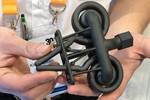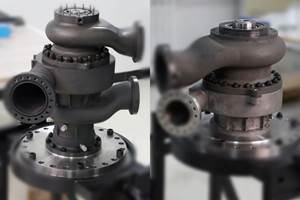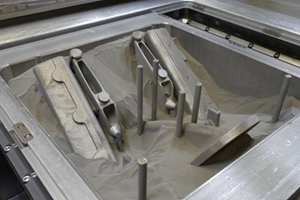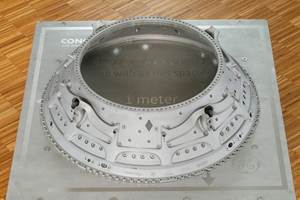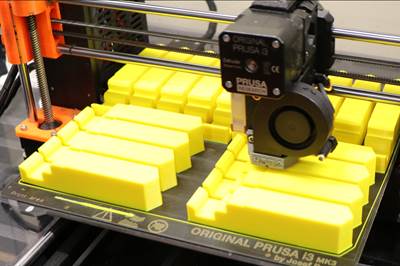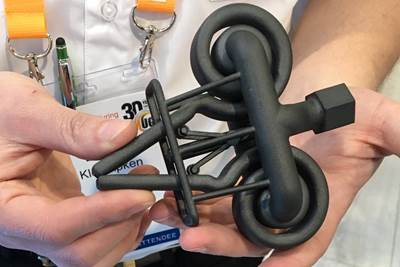BMW Expands Use of Additive Manufacturing to Foster Production Innovations
The BMW Group is manufacturing many work aids and tools for its own production system using various 3D printing processes, with items such as tailor-made orthoses for employees, teaching and production aids, and large, weight-optimized robot grippers, which are used for such things as carbon fiber-reinforced polymer roofs and entire floor assemblies.
Robot grippers cast with 3D printed sand molds are used in Plant Munich to move entire floor assemblies. Source: BMW Group
In addition to concept cars, prototyping and some production parts, the BMW Group is now using additive manufacturing (AM) to quickly, economically and flexibly produce its own production aids and robot tooling, which it can individually adapt to specific requirements at any time, as well as optimize their weight.
At the Additive Manufacturing Campus in Oberschleißheim — the BMW Group’s central hub for production, research and training in 3D printing — more than 300,000 parts were printed in 2023. Also, more than 100,000 other printed parts were produced per year across all the plants that form the global production network, from Spartanburg and the German plants to sites in Asia.
With more than 30 years of AM experience, the BMW Group has used AM printers from as early as 1991 to produce individual vehicle parts and components, initially for concept cars, prototypes and race cars, then later for production models. Now, the BMW Group is manufacturing many work aids and tools for its own production system using various 3D printing processes.
This expansion of production aids created through AM includes tailor-made orthoses for employees; teaching and manufacturing aids; and large, weight-optimized robot grippers, which are used for handling such things as carbon fiber-reinforced polymer (CFRP) roofs and entire floor assemblies.
“The increasing use of additive manufacturing in the BMW Group production system has many benefits. For example, we are able to quickly, economically and flexibly produce our own production aids and handling robots, which we can individually adapt to specific requirements at any time, as well as being able to optimize their weight,” says Jens Ertel, head of BMW Additive Manufacturing. “Less weight allows higher speeds on the production line, shorter cycle times and reduced costs. Plus, smaller robots can be used in the medium term, which also cuts CO2 emissions and costs.”
This topology-optimized robot gripper in Plant Landshut is used to both load CFRP material into a press and remove the finished parts. Source: BMW Group
As well as the direct AM procedure, the BMW Group has also been using sand-based 3D printing to create molds for many years at its site in Landshut. “This technology is typically used to manufacture prototype casts, as well as for the large-scale production of components for high-performance motors. Another very attractive field of application is now that of large production aids,” says Klaus Sammer, head of Product and Process Planning for Light Metal Casting.
Time Savings, Economics and Sustainability
For a number of years, the BMW Group’s Lightweight Construction and Technology Center in Landshut has been using a particularly large gripper element (pictured above), which was made using the 3D printing process. Weighing around 120 kilograms, the robot gripper can be manufactured in just 22 hours and is then used on a press in the production of all CFRP roofs for BMW M models. The press is first loaded with the CFRP raw material. The gripper is simply rotated 180 degrees to remove the finished roofs.
“We are able to quickly, economically and flexibly produce our own production aids and handling robots, which we can individually adapt to specific requirements at any time, as well as being able to optimize their weight.”
Compared to conventional grippers, the version manufactured using 3D printing was roughly 20% lighter, which can extend the operating life of the robots, reduce wear and tear on the system, and cut maintenance intervals. The combined use for two steps also reduced cycle time.
BMW says a unique feature of the robot gripper is the ideal combination of two different 3D printing processes. While the vacuum grippers and the clamps for the needle gripper to lift the CFRP raw material are made using selective laser sintering (SLS), the large roof shell and bearing structure are manufactured using large-format additive manufacturing (LFAM). LFAM can be used to produce large components economically and sustainably. The process uses injection molding granules and recycled plastics, while CFRP residual material can also be used and recycled. Compared to the use of primary raw materials, CO2 emissions when manufacturing the gripper are roughly 60% lower.
Lightweighting, Optimizing Robot Grippers
In the summer of 2023, a new, even lighter generation of the roof gripper was introduced. To achieve this, the previous gripper concept was analyzed and optimized topologically, leading to the creation of the bionic robot gripper. This design combines the roof shell from the LFAM printer with SLS vacuums and a bionically optimized bearing structure. To produce the tool, a mold with printed cores is used in sand casting the intricate aluminum structure.
The new gripper is 25% lighter than its predecessor, meaning the entire process of manufacturing a CFRP roof of the BMW M3 can be performed with just one robot, rather than three as was previously the case. Now, double grippers manufactured within the BMW Group through 3D printing are used for all CFRP roofs at BMW Group Plant Landshut.
New 3D Printed Gripper Also Used in Chassis Construction
The BMW Group also employs grippers produced using the 3D printing process in chassis construction; for example, grippers printed with the LFAM process are used for handling doors at the BMW Group Plant Regensburg.
“With an optimized bearing structure produced using 3D printing, we were able to increase the rigidity of the gripper when handling door elements at the plant in Regensburg, while at the same time reducing weight,” says Florian Riebel, head of Door and Flap Production in Regensburg. “In subsequent projects, it is then possible to use robots with a low bearing capacity, which helps to cut costs.”
However, the company is now taking it one step further at BMW Group Plant Munich. Recently, the first examples of a bionic robot gripper have been used at the parent plant. This gripper can hold and move the entire floor assembly of a BMW ili. For the floor assembly gripper, 3D printing is used to create a sand casting mold, which is filled with liquid aluminum. The tool is optimized in terms of weight and maximum load capacity, and weighs with all additional add-on elements a mere 110 kilograms. That makes it roughly 30% lighter than the previous, conventional model. Manufacturing using sand casting and aluminum makes it possible to represent intricate load-optimized structures. This results in maximum weight reduction and thus makes it possible in the medium term to use smaller and lighter heavy-duty lifting robots, which require less energy and thus reduce CO2 emissions.
“At the Munich plant, we are continuously expanding the use of production aids created through additive manufacturing,” says Markus Lehmann, head of Plant Engineering and Robotics at BMW Group Plant Munich. “When it comes to the field of gripper and handling systems, we use 3D printing to equip our established grippers with individual, printed attachments and are already replacing complete gripper systems with highly integrated and weight-optimized bearing structures. When handling the full BMW ili floor assembly, this allowed us to reduce the weight of the complete gripper by 30% (50 kg) and thus to extend the service life of our facilities.”
Using Innovative Software Solutions
Intricate and bionic structures are designed and calculated using special generic software tools, such as Synera. BMW iVentures had strategically invested in this software, previously known as Elise. Synera enables fast and efficient optimization, and is now used in many development areas within the BMW Group. It is particularly worth using the software in 3D printing, as topologically optimized, bionic structures can virtually be printed one-to-one because of the high degree of flexibility of the 3D printing process. This makes it possible to exploit the full potential for lightweight construction.
The BMW Group's Additive Manufacturing Campus is home to a team of design and construction specialists who compare a diverse range of software solutions and use them to design components. The knowledge is then passed on throughout the company via the Additive Manufacturing Campus. In the case of gripper design, special workflows have been developed and implemented, which enable the calculation and construction of the bearing structure to be largely automated, and thus fast and efficient.
Related Content
Reusable LOX/Kerosene Engine Completes First Successful Full-System Test Flight
Galactic Energy Space Technology announced the first successful full-system test flight of its Welkin 50-ton reusable LOX/kerosene engine. To date, this is the highest thrust LOX/kerosene engine in the Chinese commercial aerospace playing field which has officially entered the engineering and manufacturing phase.
Read More8 Cool Parts From Formnext 2023: The Cool Parts Show #65
New additive manufacturing technologies on display at Formnext were in many cases producing notable end-use components. Here are some of the coolest parts we found at this year’s show.
Read MoreIndyCar's 3D Printed Top Frame Increases Driver Safety
The IndyCar titanium top frame is a safety device standard to all the series' cars. The 3D printed titanium component holds the aeroscreen and protects drivers on the track.
Read MoreGE Additive Helps Build Large Metal 3D Printed Aerospace Part
The research is part of an initiative to develop more fuel-efficient air transport technologies as well as a strong, globally competitive aeronautical industry supply chain in Europe.
Read MoreRead Next
Ford is Saving Millions through 3D Printing (But Maybe Not How You Think)
Two longtime workers at Ford’s Sharonville Transmission Plant near Cincinnati grew tired of experiencing the delays and downtime resulting from expensive and hard-to-get replacement parts. The solution? Learn additive manufacturing and save the company time and money.
Read More4 Ways Robots and 3D Printing Intersect
Four examples of how robotic automation and additive manufacturing both help and are helped by each other.
Read MoreCrushable Lattices: The Lightweight Structures That Will Protect an Interplanetary Payload
NASA uses laser powder bed fusion plus chemical etching to create the lattice forms engineered to keep Mars rocks safe during a crash landing on Earth.
Read More


